For a long time, HubSpot’s Sidekick was the go-to email tracking software for salespeople.
By creating a simple browser plugin integration with Gmail, G Suite, Outlook and Office 365, Sidekick built considerable market share with a low barrier to entry and a surprisingly advanced feature set for a free tool.
In 2016, HubSpot announced the rebranding of Sidekick to HubSpot Sales, which was bundled as part of the HubSpot CRM and Sales product suite.
While having little impact on those already using HubSpot’s CRM, this greatly impacted businesses using Sidekick alongside another CRM or users who did not use a CRM at all.
Sometimes you just want to track emails.
If you don’t use HubSpot CRM, there are HubSpot Sidekick replacements available. In some cases, you can build a more effective lead campaign tool by combining various point solutions.
Note: Want to see which companies visiting your website—even if they don’t fill out a form? Try Leadfeeder for free.
4 HubSpot Sidekick replacements
An email tracking tool tells you who’s opening your messages, links, and attachments—and provides a simple indication of engagement with your outgoing emails.
But it’s important to understand what happens after a recipient actually opens one of your emails. Typically, your email will direct someone to your website. How do you track website visitor engagement?
What I describe below is a solution that works for more than just email. It’s a holistic approach that can encompass all the important parts of a lead generation campaign, not just email.
I’ve highlighted three tools below that provide insights across email, web and phone.
When you combine these tools, you have an intelligent lead tracking solution that doesn’t require buying into the HubSpot Sales suite, or any other third-party CRM if you don’t use one (although I do recommend using one).
Leadfeeder: Automated website visitor tracking
We built Leadfeeder as a website visitor tracking tool to tell you what companies are visiting your website, even if the company does not fill out a form or download a resource.
Leadfeeder features
Using a website visitor tracking tool (which is similar to analytics, but with the ability to identify which individual companies visit your website) is an effective method of lead generation.
By identifying the businesses visiting your site, monitoring the pages they visit, and the content they read, you may develop outreach and engagement opportunities with them based on their actual site engagement.
Once installed, Leadfeeder provides a dashboard with all of the businesses that have visited your site, including the content they have viewed, at what point they visited, and the actions that were taken.

Leadfeeder has a number of CRM integrations to which you can send leads. It can even act as a standalone CRM if required.
Pricing starts at $55 per month.
Leadfeeder benefits
Leadfeeder uses machine learning and AI to pull data using our Leadfeeder Tracker script.
Once the Leadfeeder Tracker script is installed and your Google Analytics is integrated, your data will start populating in the Leadfeeder dashboard.
B2B companies use the data in Leadfeeder to drive their account based marketing, lead generation, and sales prospecting strategy.
Leadfeeder integrates with CRMs like HubSpot and Pipedrive. And, other marketing tools like MailChimp, Salesforce, Zoho, Slack, Zapier, and more.
Leadfeeder installation
To sign up for a free 14-day trial of Leadfeeder, follow these steps.
Important note: A Google Analytics account is required to complete the set-up of Leadfeeder.
Step 1: Click here to sign-up for a free 14-day trial of Leadfeeder.

Step 2: Click to connect your Google Analytics account.

Step 3: Select the Google Analytics account you want to work with.

Step 4: Select the Google Analytics view would like to see. Leadfeeder will let you use 10 views per Google Analytics account.

Step 5: Confirm your company name then click “Create Account.”
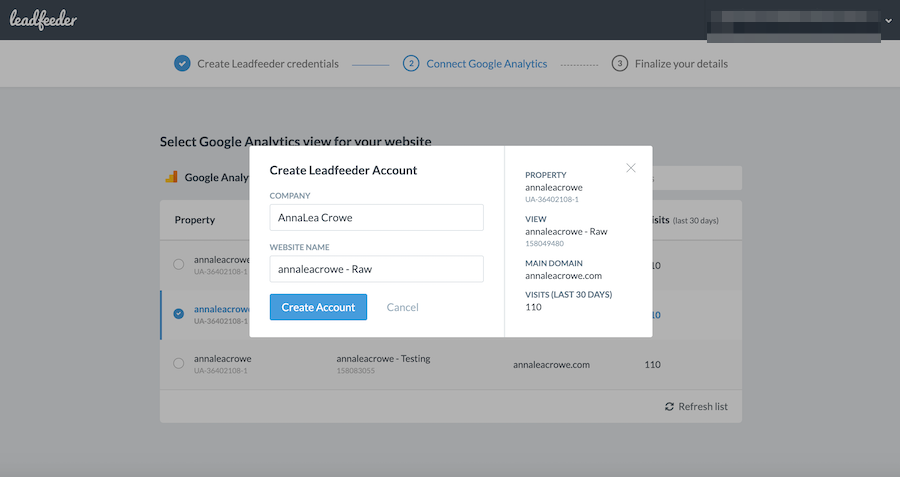
Step 6: Finalize your company information.
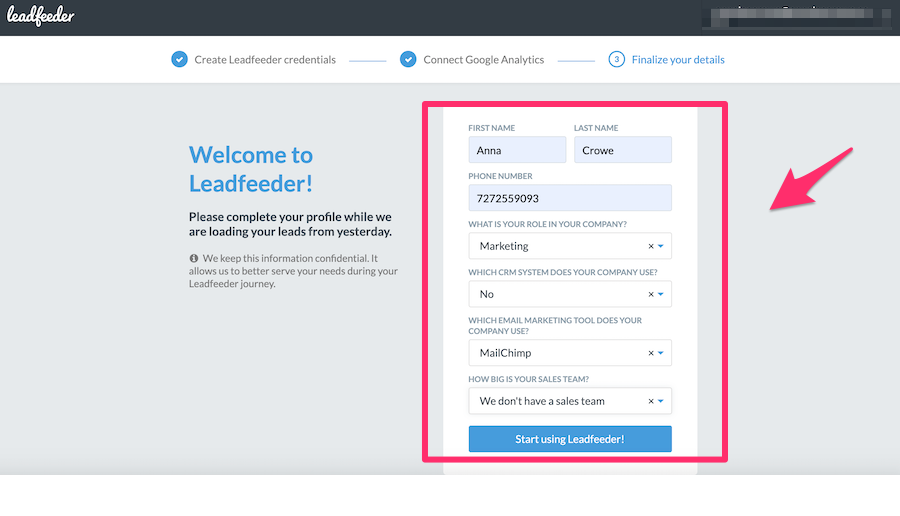
Step 7: Install the Leadfeeder Tracker script on your site.
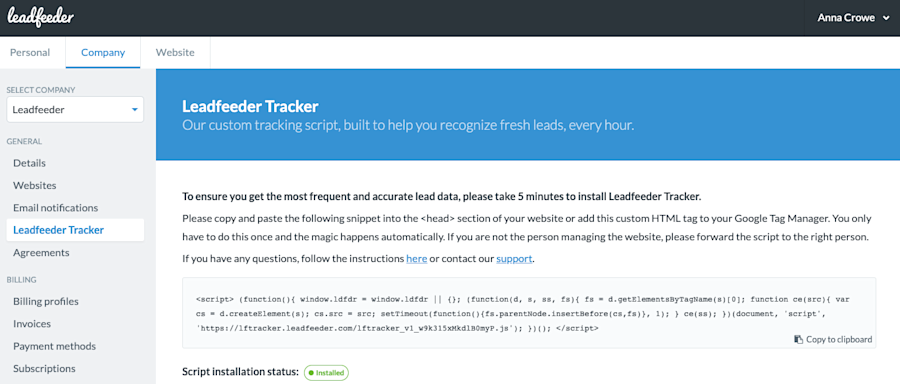
Step 8: That simple! You’re done. 🎉 I recommend going through the tour.

Yesware: A standalone email-tracking tool
Yesware is a standalone email tracking tool that is best suited for most users in replacing Sidekick.
Like Sidekick, Yesware has native integrations with Gmail, G Suite, Outlook and Office 365.
Yesware features
Yesware offers basic email tracking features such as email opens, click tracking and attachment engagement—and because of the Google and Outlook integrations, you don’t need a third-party software or email client to make use of its features.

Yesware also offers the ability to schedule emails to send later (useful if you want to type up your emails Friday evening and schedule to send Monday morning) as well as set reminders for emails you need to follow up on.

Yesware benefits
Like Sidekick, Yesware also allows you to set up templates and mail merge, where you can inject personalized content based on your contacts’ stored information.
Depending on your lead type, you can increase your productivity and response rate by using the template system.
If you need advanced campaign features, Yesware also includes a campaign mode so you can build entire campaign funnels, although you can get by with just the basic email tracking solution.
If you use Salesforce, you also have the option of integrating Yesware with Salesforce CRM, (but this is not necessary).
Yesware installation
Because of the native integrations, sign up is very simple and only takes a few clicks to install the browser extension and integrate Yesware within your email platform.
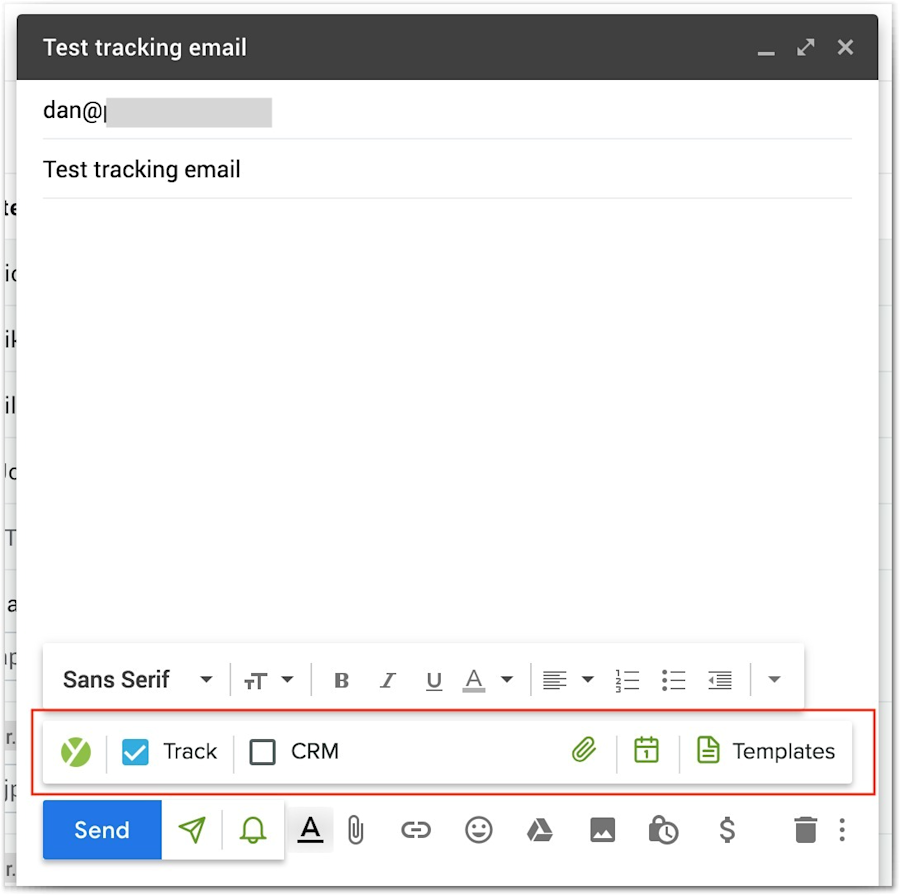
Once the extension is installed, simply reload your email and the Yesware tracking options will be viewable and you may begin sending tracked emails.

The Yesware integration adds a tracking module in your mail client view, allowing you to easily see your tracked emails and their engagement.

While there is no free tier, Yesware does offer a 4-week free trial and monthly pricing plans that start at $15 per month.
Mailtrack: A Gmail-only alternative to Yesware
Mailtrack is a lighter client than Yesware as it only integrates with Gmail. While Mailtrack’s free tier has limited functionality, it still offers basic tracking capabilities.
Mailtrack installation
Mailtrack installation is simple and only requires a few clicks to integrate the browser plugin within your Gmail account.
Once installed, sending a tracked email is the same as Yesware. Compose an email and you will see the Mailtrack “tick” indicators to let you know the email will be tracked.
Mailtrack’s free plan has a branded message at the bottom of all emails.
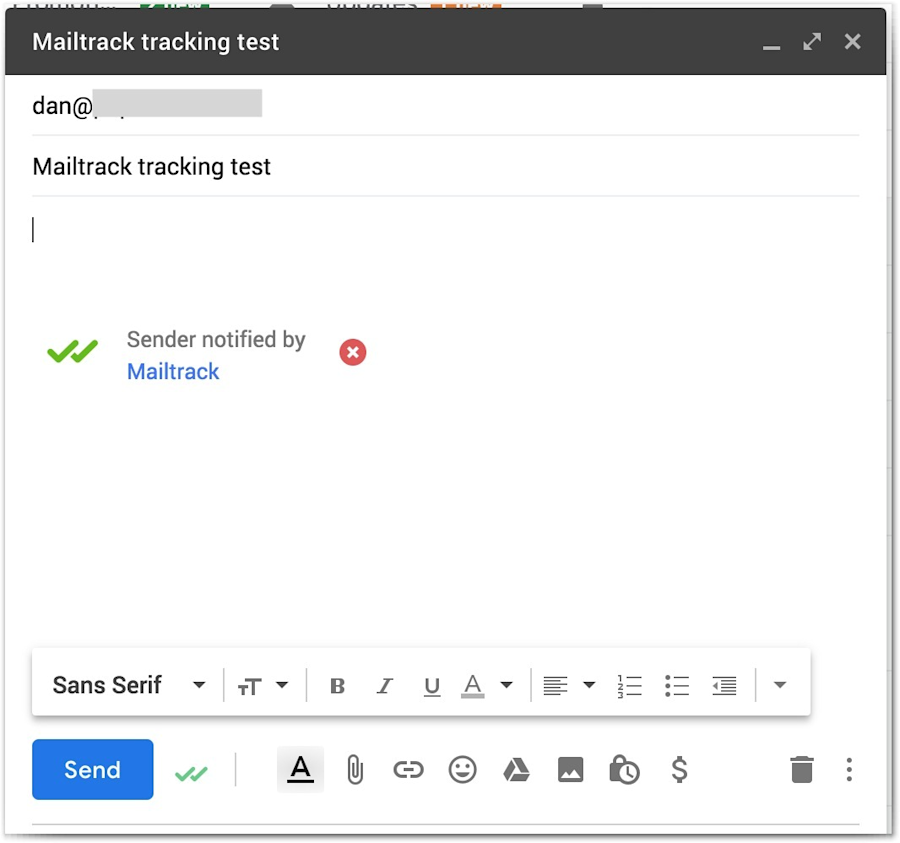
You will receive a desktop notification every time the receiver engages with the email.

And you can even set up email alerts for specific emails.

Mailtrack benefits & features
While Mailtrack offers an activity dashboard, it does not have the advanced campaign capabilities, or the scheduling and reminder capabilities that Yesware provides.
If you only need email tracking and you use Gmail, Mailtrack is an excellent solution for you.
Mailtrack has only two pricing tiers, a “Free” and a “Pro” plan that can be purchased for $10 per month.
The “Pro” plan also includes Gmail for Android support, something very few email tracking tools offer.

Boomerang
If you decide to use Mailtrack and would still like to use scheduling and reminders, Boomerang for Gmail is an excellent third-party email scheduling tool.

Boomerang features
Boomerang for Gmail allows you to schedule when you want your emails to be sent. It also allows you to set reminders for when you don’t hear back from your contacts.
Boomerang offers iOS and Android integrations, so you can write emails on the go that will arrive in your inbox when you wantto be reminded about them.
Boomerang installation
Boomerang installation is a simple one-click process that allows you to immediately begin scheduling emails the next time you compose one.
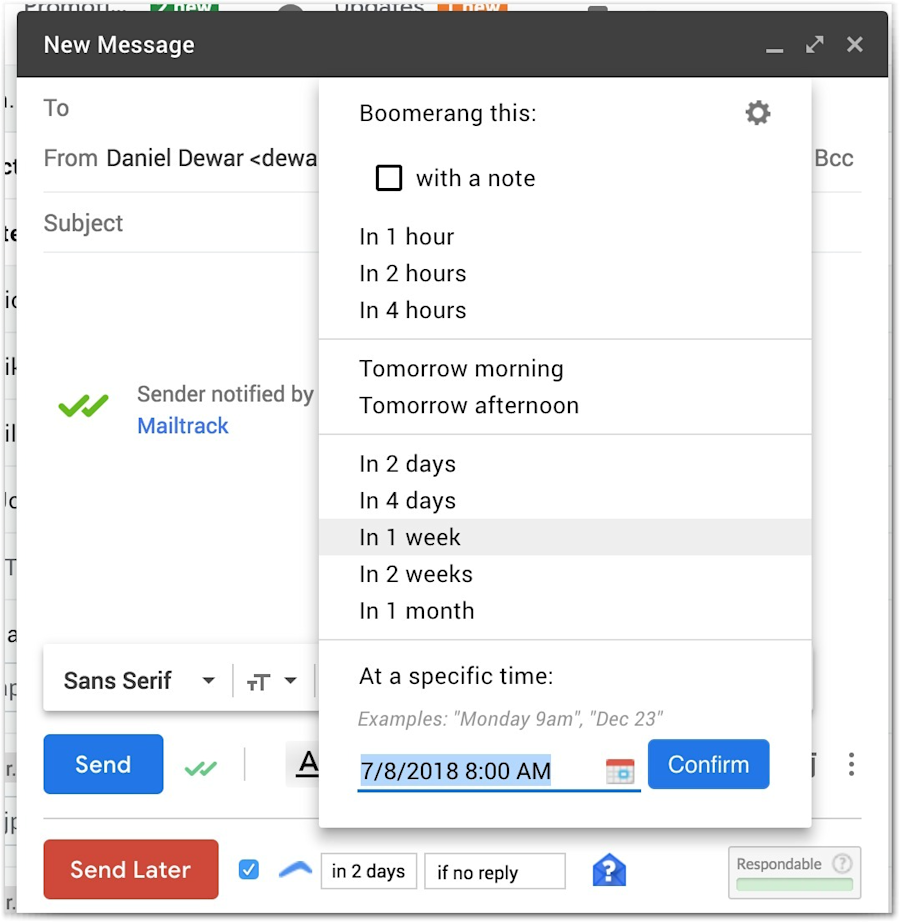
Boomerang’s “Free” tier should be enough for most users, but pricing starts at $5 per month for increased usage credits.
The paid tiers give you unlimited message credits, access to the iOS and Android integrations, and more advanced features—such as Boomerang’s machine-learning suggested-response product, Respondable.
Boomerang also has a pause inbox feature and recurring message scheduling.

BONUS REPLACEMENT TOOL!
Docsify: Free email tracking and Gmail productivity suite
A bonus option to the aforementioned alternatives, is Docsify. As a Gmail-only alternative, it trumps Mailtrack in a couple of ways.
Docsify offers productivity features that are highly unique, such as per-recipient email tracking and per-page PDF tracking, and our favorite—email templates.
Docsify installation
Much like Mailtrack and Yesware, Docsify allows you to connect via its Chrome extension in the Chrome Web Store. You integrate the plugin via your Gmail account.

The beauty of Docsify, is that it was created with the salesperson in-mind.
Although it is free to use Docsify up to a limited number of messages per month, if you use a paid account, the dashboard view and analytics data that it affords can offer interesting insights about your pipeline health via email—a feature that feels a bit more Hubspot-like.
Docsify features and benefits
Much like the other options, with Docsify, you send emails as usual and track them by default.
Unlike Mailtrack, you can change the default settings at any time in the Admin Panel, and not just track Opens, but you can also auto-track Clicks and Views of attachments.

When a recipient performs any of these actions, you receive real-time push and email notifications.
And these insights about recipients’ actions can all be viewed within your Gmail account.
This data is easily accessible by clicking on the “Docsify” green icon in the Sent Folder and then choosing the Documents icon:
How many seconds/mins your recipient spent on each page of a document
The depth of view of the document (in %)
General time of view
What device and OS the recipient uses, desktop or mobile; Windows or IOS
In what particular order emails were read (Timeline tab)
Prioritize leads by the level of engagement and contact the most-engaged ones first
Docsify is honestly a cut-above with its sales-minded features, which makes it a perfect Bonus replacement for those Hubspot-Sidekickless folks out there that excusively use Gmail for email tracking and prospecting.
How to combine these into a lead campaign tool
While these point solutions aren’t integrated, it is very simple to get them to work together for a lead generation campaign.
What all of these tools have in common is the ability to identify based on a common identification point—a business identifier.
Whether it’s an email domain or the business IP address — these identification points can be used to connect each of these platforms.
Let’s look at a simple example.
Let’s say I’ve built a SaaS-based booking system and WeWork is a prospective user (due to their booking requirements for their meeting and function rooms).
I can research the relevant contacts at WeWork to reach out to (using LinkedIn and job title filtering). I can build a contact list of WeWork prospects.
Using Yesware or Mailtrack, I can set up notifications for any opens or clicks to emails I send to a WeWork domain email.
Using Leadfeeder, I can set up an email or Slack alert anytime someone from WeWork visits my site. I can even set an alert based on specific actions or page visits.
So, what do I have now?
I have an automated lead campaign tool that alerts me anytime someone from WeWork engages with an email I have sent or visits my website.
Using the real-time alerts, I can then make the appropriate action to push those visitors further down the sales funnel.
I can trigger a live chat tailored to their customer journey stage based on their site visits or email referral link.
I can even trigger a landing page tailored to the content in the email I have just sent. After all,
It’s a very simple process to replace HubSpot Sidekick.
And even without a CRM, I have just demonstrated how to build an effective lead campaign tool by combining various point solutions to drive lead conversions.
Now that you're here
Leadfeeder is a tool that shows you companies that visit your website. Leadfeeder generates new leads, offers insight on your customers and can help you increase your marketing ROI.
If you liked this blog post, you'll probably love Leadfeeder, too.
Sign up




